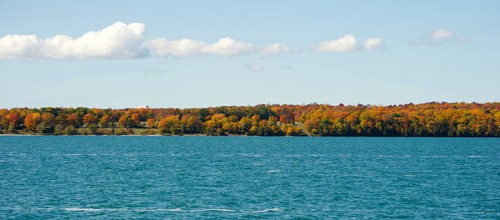LAKE MINDEMOYA – The concept of having a stocking program on Lake Mindemoya or a fish hatchery is not quite dead yet, as far as proponents are concerned.
“I think the point I made in the release I wrote last week is that the ministry (Natural Resources and Forestry, MNRF) is saying the cost is too high to rise walleye to the size of around four inches, so they have the best chance of survival from predation,” said Marcus Mohr, community development/outreach co-ordinator in Central Manitoulin. “It may be too expensive in their minds, but we would like to know exactly how much it would be.”
“Mr. (Wayne) Selinger (of MNRF) stated you would need at least 50,000 four-inch walleye a year to make a difference in Lake Mindemoya and they don’t have the fish culture station infrastructure provincially to do a project of that size. They also stated that a community hatchery would be a waste of time and money,” said Mr. Mohr.
The report basically states that MNRF has no intention of stocking Lake Mindemoya as the lake is not at the point where it would typically be stocked, that the lake is still self-sustaining and has healthy walleye, although numbers have been declining and did so drastically between 2005 and 2009. They state it will likely improve with time, with a positive note that there may be a turning point on the rainbow smelt issue as there were no invasive rainbow smelt caught in the 2017 net survey, however they were noted in the stomachs of some fish and the nets they use are not really designed to catch them. Further, that a unique strain of walleye exists in Lake Mindemoya and that if it got to a point where it would need to be stocked it should, in their opinion, be that genetic strain.
“Having a unique genetic strain identified complicates the issue further,” said Mr. Mohr. “Trying to locate spawning walleye is a difficult, more expensive and laborious process and we would agree with that statement that locating the walleye is difficult as some members of the call have tried this method before on Lake Mindemoya with little to no success,” continued Mr. Mohr. “There were no actual monetary figures given in the presentation or the report so we currently cannot comment on whether we agree that it would be too expensive.”
“Lake Mindemoya’s ecosystem has changed drastically due to two invasive species, first being the zebra mussels that filter out the zooplankton, which young walleye use as their food source. Zebra mussels basically eat out the bottom of the food chain and have no effective predators. There is no known large-scale way to rid a sizable lake of this invasive species,” continued Mr. Mohr.
“The second invasive species is the rainbow smelt. According to Mr. Selinger, he states that they affect the walleye in several ways: they prey on fry and fingerling walleye, they compete for food sources and they are themselves food for larger walleye. Generally being a food source for the walleye may be a good thing except that they are a very energy-rich food source and they think that the walleye feeding patterns change with it. This means they are eating less often on traditional food sources or even travelling to areas of those traditional food sources and thus less susceptible to traditional angling techniques. Being ‘susceptible to anglers’ or being able to catch fish, in this case walleye, is the reason we are all concerned and why the municipality is addressing this declining walleye and lake health situation as it pertains to the economy of attracting visitors to accommodations, providing a source of income for many people in the area and much needed recreation contributing to quality of life.”
“Further, it is more desirable to live on a sport fishing lake, and this influences purchasing decisions of home buyers,” continued Mr. Mohr. “The fishery is a natural resource, a resource that can be used sustainably as part of an economy as it should replenish itself or in some cases have assistance by way of stocking or other measures by the Ministry of Natural Resources. Mr. Selinger told us that the lake has changed, the Lake Mindemoya we knew is not coming back, there’s no plan for it and there’s nothing we can do about it.”
“I’m going to be sending more questions to the MNRF on this and their study,” Mr. Mohr told the Recorder. As for next steps, Mr. Mohr said, “moving forward, in preparation for the potential to stock this DNA variant back into the lake, if it comes to that point, we are asking community members and neighbouring community members to reach out to us with information regarding known spawning locations and times on Lake Mindemoya. You can contact me at 705-377-5726 or by email at centralecdev@amtelecom.net. These spawning locations would be kept confidential to protect the spawning grounds.”
Mr. Mohr added, “a few other avenues are being looked into for logistics including radio tagging to narrow down spawning locations. I can say that some of our next questions will be whether or not maintaining the genetically distinct Mindemoya walleye is MNRF policy or an opinion. Additionally, there was a lot of talk around the stocking or other scenarios being too expensive, but no actual figures presented on what has been invested in Lake Mindemoya over the past 21 years in studies and what the estimated cost breakdown of the stocking scenarios is so that we could make that determination of being too expensive for ourselves based on a per-fish-raised versus loss of revenue and opportunities in our Manitoulin communities.”





